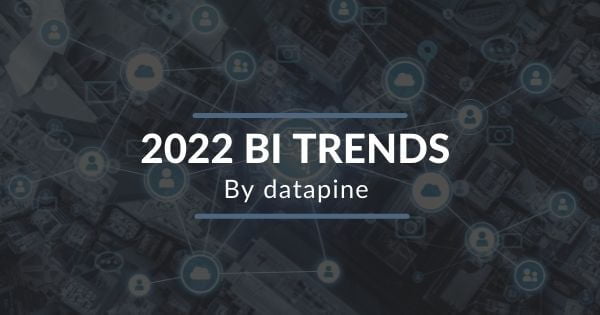
Contents
Business intelligence is a specific subset of data management that allows businesses to derive actionable insights from contextualized data.
In the modern business environment, big data is king. But data in itself doesn’t determine whether a business will succeed or not, it must be organized and contextualized in such a way that valuable insights can be gleaned and acted on.
Learn how advanced BI tools can automate this process, integrating evolving technologies like machine learning to help organizations respond to changing conditions articulated by the data they gather.
What is business intelligence?
Business intelligence, or BI, is the process by which organizations collect, organize and contextualize data, often using visualizations to make it easy to understand data-driven insights at a glance. The term originated in the 1960s and has expanded in meaning; today, BI refers to a wide range of data-related activities, including data mining, reporting, visualization, and querying.
“Business intelligence can mean something different at each company, but at the core of it, the BI team is responsible for collecting, managing, and analyzing data in order to drive business insights,” said Kevin Hoe, senior data analyst at business.com. “Many definitions might focus exclusively on the data side of the coin, but the other side is equally important: cross-team collaboration. Having all the data in the world might mean nothing without properly understanding the business context, which only comes from collaborating with teams across the organization.”
While business intelligence is based on the data you collect from myriad sources – accounting software, CRM software, inventory management software, website traffic – a business intelligence tool pulls unstructured data together and packages it in simple, easy-to-understand reports and visualizations. BI software also ensures the data can be easily queried and filtered, helping you to review the information you need when you need it.
“The output of business intelligence is usually a dashboard or some kind of visual means to organize the data as to tell us a story,” said Rosaria Silipo, Ph.D., principal data scientist at KNIME. “That story could be anything: from revenue trend to machinery monitoring, from number of working hours to investment ROIs.”
A good BI tool makes it easy to understand and filter the vast troves of data a business collects. Virtually everyone in an organization should be able to make use of business intelligence – without needing a data scientist to do so.
“The role of business intelligence is to provide you with an easily understandable insight into your data,” Silipo said. “There are many tools that build dashboards and manage data for you. Some of those tools are quite easy to manage, and you need very little additional skills to understand your own data.”
Benefits of using business intelligence
“Business intelligence provides insight about the organization, its customers and its products,” said Travis Fell, product manager for Hypori. “A company uses business intelligence to improve operations, customer service and competitive advantage. “
Business intelligence can support business objectives by providing a panoramic view of all the information an organization collects and helping key stakeholders make more informed decisions, identify key benchmarks, track metrics, and pull up specific data points on demand.
The most advanced BI systems employ machine learning algorithms, which contextualize vast troves of data, sending alerts and recommendations to decision-makers upon request or when anomalous data is catalogued.
“BI’s role is to really give business context to raw data. Without aggregation context, data is not all that useful,” said Christopher Risher, senior program manager of application management services at Onepath. “A great example is slicing financial transactions that have already been summed by some categorical data, such as a business division. With the division as additional context, we are able to glean how individual practices are doing. Then you can add additional context, such as budget or previous year comparisons. Then you start iterating to build out your BI model based on questions that the business requires to become better.”
Risher’s example is one of countless opportunities business intelligence affords a company. Overall, BI is a flexible tool that can be used to inform a wide range of business processes across many different industries. Business intelligence can be used to:
- Analyze revenue and expenses, finding opportunities to increase profitability
- Establish benchmarks based on competitors’ activities within the industry
- Profile and track customer behavior
- Measure key performance indicators and establish benchmarks against them
- Analyze market trends and use the findings to adjust processes accordingly
- Identify and address issues before they become productivity draining problems
“The benefits of business intelligence can vary greatly by the industry and what kind of application the business is utilizing,” said Bill Szybillo, BI manager at VAI. “For example, a food distributor or processor can use business intelligence tools to gain insights into their supply chain, such as inventory levels, supply and demand trends, order status, and more. This kind of data is not only valuable for streamlining warehouse operations but can also be used by sales and marketing teams to better communicate with current and potential customers.”
One of the biggest advantages offered by BI tools today is that they enable nontechnical team members to take advantage of the data-driven insights business intelligence provides.
“From an insights standpoint, BI tools can help an organization track and report on key metrics that drive the business’s success,” Hoe said. “Taking that one step further, a robust BI practice can help teams across the company surface up insights by looking at data in novel ways. One outcome might point to low-hanging fruit, such as there being additional high-margin inventory to sell when the sales team initially thought that everything was sold; another outcome could be that SMBs uncover product growth opportunities as a result of BI providing greater visibility into the businesses’ operations and trends.
“Now there are products that automatically manage and scale a company’s data infrastructure or run advanced tests that used to be the realm of only data scientists. Data is not just for the BI team, but for all teams across the company,” Hoe added.
Integrating BI tools with other business software
Additionally, business intelligence tools can integrate with other systems a company uses daily to improve the organization of data and the insights it can derive from it. A BI tool is most effective when contextualizing wide-ranging, often disparate data, breaking down data silos and providing easy access to the information to the teams that need it most.
“Other benefits come from the business intelligence solution itself and the various integrations that can be done with it,” Szybillo said. “Automated business intelligence tools that integrate into an ERP solution, for example, are a way for insights to be automatically gathered and analyzed by IT teams and stored in one central database like the cloud. The entire enterprise can then access and use this data to make more informed decisions and see ROI.”
What’s the difference between business intelligence and business analytics?
Technically, business intelligence is used to make more informed decisions in the here and now, while business analytics, or data analytics, are used to anticipate future circumstances and guide your business operations accordingly. This difference is subtle, but significant. Put simply, business intelligence offers a snapshot of the present and recent past, while business analytics makes educated assumptions about the future. Both require contextualized data to work to their full potential.
“Business intelligence usually is limited to data summarization and a visual display of the results,” Silipo said. “[Business analytics] takes the data to the next level by using statistics and machine-learning algorithms to make predictions and automatically generate insights.”
Any business engaged in data collection and data analytics should incorporate both BI and business analytics into their operations. While these concepts are distinct, they are closely related, so the BI team and business analytics team should work together. In a small business, these teams might include the same members.
Artificial intelligence, business intelligence and predictive analytics
The most advanced BI tools use innovative technologies like machine learning and artificial intelligence to automate certain tasks and improve the responsiveness of organization to data-driven insights gathered by the BI team.
“Business intelligence coupled with artificial intelligence can make a huge difference in solving problems such as customer retention, performance and operational management, visibility, and more,” Szybillo said. “Driving intelligence from customer data and using this data to make more informed decisions on behalf of clients is one of the most important goals of implementing a BI strategy. Other common problems are performance or operational inefficiencies, such as employees traditionally having to manually create customer reports or manually track inventory, wasting valuable time.”
Businesses can leverage BI tools coupled with machine-learning algorithms to achieve these goals, Szybillo added. Further, artificial intelligence enables the automation of certain processes previously reserved for manual human labor.
For example, data gathered from machinery operating within a factory can be integrated with a BI tool to identify trends of machinery performance over time. This can be observed by a human operator to determine whether the production cycle is slowing; if so, they could work further to identify which machine is in need of service, dispatching a technician to perform maintenance before the problem results in downtime and a loss of productivity. Some BI tools can identify the specific part of the machinery that is underperforming, such as by identifying that the motor is overheating.
With machine learning in this example, automated alerts could be configured to dispatch the maintenance tech without any human intervention. A non-AI BI tool requires human observation and reaction to the data being contextualized. With AI, these tools can respond in real time to simple requests when triggered.
Business intelligence is an increasingly important part of modern business. When coupled with business analytics, BI offers an ability to better understand the past and present, while predicting the future and responding accordingly. Businesses that implement BI into their operations stand a better chance of gaining a competitive advantage and keeping it, optimizing their operations based on data-driven insights, and making future decisions based on a more accurate prediction of what the future might hold.
[“source=business”]












































